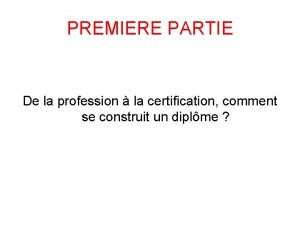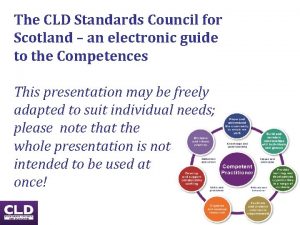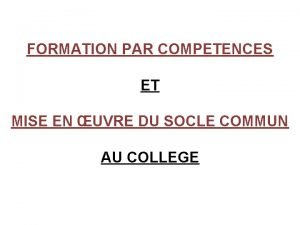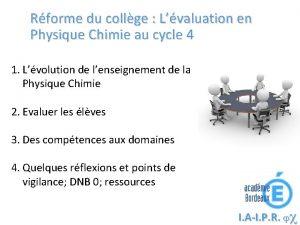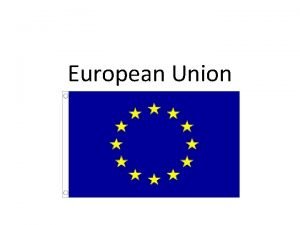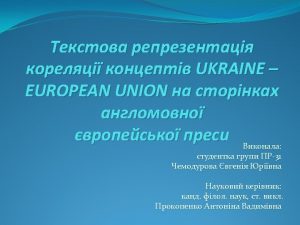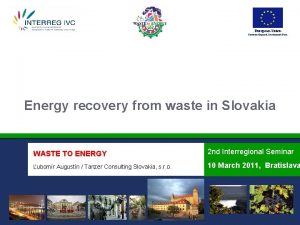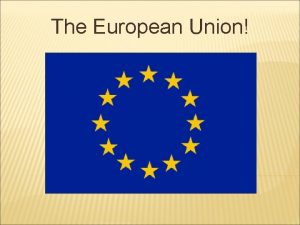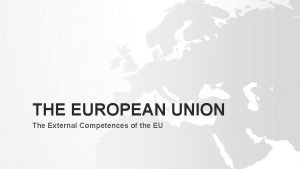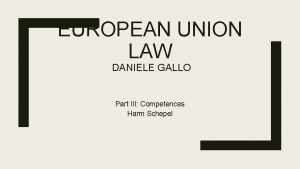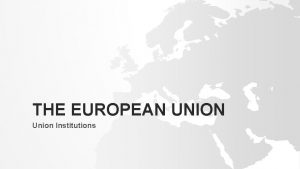THE EUROPEAN UNION Competences Procedures Legislative Procedures In











![SUBSIDARITY AS A JUDICIAL SAFEGUARD? Case C-84/94 UK v Council (Working Time) [1996] ECR SUBSIDARITY AS A JUDICIAL SAFEGUARD? Case C-84/94 UK v Council (Working Time) [1996] ECR](https://slidetodoc.com/presentation_image/0fa855b22703dcecf2ae872baf0fd734/image-12.jpg)


- Slides: 14

THE EUROPEAN UNION Competences & Procedures; Legislative Procedures

In these slides… COMPETENCES PROCEDURES - The scope of Union competences - Ordinary procedures - Teleological interpretation - The Union competences: - General competences - Categories - Five competences of the Union - Ordinary legislative procedure - Special procedures - The principle of subsidiarity

THE SCOPE OF UNION COMPETENCES Legislation • Art 289(3) TFEU: “Legal acts adopted by legislative procedure shall constitute legislative acts. ” • The scope of the EU’s legislative competences is limited as the EU is not a sovereign state. Scope of Union Competences • Under the principle of conferral the Union can only act within the limits of the competences conferred upon it by the Member States, see Art 5(2) TEU. • A legislative competence is the material field within which an authority is entitled to legislate. • Each legal competence for every Union Activity in the respective Treaty title. • The treaties present a picture of thematically limited competences in distinct policy area SCHUTZE. EU

TELEOLOGICAL INTERPRETATION Now we turn to the ‘basics’ of discussing Union competences: the principle of conferral, which can be interpreted in two different ways, namely: Strict… OR would deny the Union the power to interpret its own competences. This comes with the practical problem that each legislative bill would need to gain the consent of every national parliament. (in dubio mitius; International method of interpretation in line with intention of member states. ) Soft… Allows for teleological interpretation of competences. This method asks what is the purpose of a rule. This can allow a small amendment to the original rule. The EU adopts a soft teleological interpretation See Case C-84/94 UK v Council [1996] ECR I 5755 European Court of Justice accepts a teleological interpretation of the Union competences and it also interprets Union legislation in a teleological manner as well. SCHUTZE. EU See Case 9/74 Casagrande v Landeshauptstadt Munchen [1974] ECR 773 Teleological interpretation of the Union legislation allows the EU to apply legislation to areas that are within the Member State competences.

THE GENERAL COMPETENCES OF THE UNION • The Treaties grant special competences within each policy area. (For example the Union’s competence on environmental protection (Art 192 TFEU) is found in the Treaty’s title dedicated to the environment. (Title XX of Part III of the TFEU) • The EU is entitled to adopt measures for the approximation of national laws that relate The Harmonisation Competence; Article 114 The Residual Competence; Article 352 SCHUTZE. EU to the internal market. • Case C-350/92 Spain v Council[1995] ECR 1 -1985 • Art 114 cannot be used to create new law, European law should further the creation of a single internal market and it has to be harmonising pre-existing national laws. • Constitutional limits of the Harmonisation principle confirmed in; Case C-376/98 Tobacco Advertising [2000] ECR I-8419; The law must harmonise national laws, a slight difference in law is not enough and the law must contribute to the elimination of obstacles. • If an action is deemed necessary to meet the EU objectives and the necessary powers aren’t available the Council acting on a proposal from the Commission after obtaining the permission of Parliament to adopt the action. • Can be used to develop an existing policy title or to develop a new one. • Limitations; 1 - Measures shall not entail the harmonisation, 2 - Cannot be used in relation to Common Foreign & Security Policy. • Big changes cannot happen through this Article. (Opinion 2/94 look at paragraph 29 -30)

THE CATEGORIES OF UNION COMPETENCES • The original Treaties did not specify the relationship between European and national competences. (Louis, 1979) • Two theories relating to competences; I. Exclusive competences; Member states transferred their powers in relation to competences within the treaties. II. Shared competences; Member states did not have exclusive rights to act within their territory as the Union shares in the exercise of public functions. • Article 2 TFEU; Established there being. SCHUTZE. EU 4 competences.

THE FIVE COMPETENCES Article 3 Exclusive Competences • Only one governmental level is entitled to act autonomously. • Exclusive competency areas; Article 5 TFEU-5 exclusive competency areas: 1 - The Customs Union, 2 - The establishment of the competition rules for the functioning of the internal market, 3 - Monetary policy (states with the euro), 4 - Conservation of marine biology (common fisheries policy), 5 - The Common Commercial Policy, Article 4 Shared Competences • Ordinary competences of the EU. Within one field either the EU or the Member State can exercise their shared competence. • In relation to technological development, space, development co-operation and humanitarian aid both Member States and the EU can legislate upon rather than ‘either, or. ’ (parallel competence) • Minimum standard competences; limits the Union to the adoption of a common minimum. Member states can introduce more stringent protective measures that exceed the minimum. • See Fornasar v Sante Chiararcosso [2000] ECR I-4785 in regards of whether a soft or hard constitutional solution should be found for minimum standard competences. Article 5 Co-ordinating Competences • Competences in which the EU and member states work together on. • Economic policy, Employment policy, Social policy. • Adoption of guidelines and initiatives organised by the EU to co-ordinate member state approaches in relation of the three policy areas. Article 6 • • Complimentary Competences Complementary areas; the protection & improvement of human health, industry, culture, tourism, education, vocational training, SCHUTZE. EU youth & sport, civil protection & administrative co-operation. Does not entail harmonisation of Member States laws or regulations.

ORDINARY AND SPECIAL PROCEDURES Article 289 TFEU: 1; “The ordinary legislative procedure shall consist in the joint adoption by the European Parliament and the Council of a regulation, directive or decision on a proposal from the Commission. ” 2; “ In the specific cases provided for by the Treaties, the adoption of a regulation, directive or decision by the European Parliament with the participation of the Council or by the latter with the participation of the European Parliament, shall constitute a special legislative procedure. ” Ordinary Legislative Procedure Parliament Council Co-Legislation SCHUTZE. EU Special Legislative Procedures Parliamentary Legislation Council Legislation

ORDINARY LEGISLATIVE PROCEDURE Proposal Stage: The Commission makes legislative proposals. (Art 294 TFEU) The bill then moves to the Council which will act by Qualified Majority to accept the bill or can reject it/amend it The amended bill is sent back to the Council and to the Commission. (that has to deliver an opinion) The Council can approve all = legislation adopted, or it goes to the next stage. Third Reading: Parliament needs to endorse the joint text and the Council must confirm it as well. If either disagree the bill fails 7 stages of the Ordinary Legislative Procedure (Art 294 & 297 TFEU) First Reading: The Commission proposal goes to the Parliament. The Parliament will act by a majority of votes cast. SCHUTZE. EU Possibility of the use of Second Reading: Parliament has three choices- can approve Councils position, reject it or can propose amendments to the Councils amendments. Conciliation Stage: Committee is delegated to draft a joint text to try to create a text that both Parliament and Council agree with. Art 297 - Signing & Publication; Signed by Presidents of the Council and the Parliament and published in the official Journal.

SPECIAL LEGISLATIVE PROCEDURE • Parliamentary legislation & Council legislation both require consent of the other generally. (Art 289(2) TFEU) • Sometimes consultation of the other institution will be required. • Consent is less that co-decision; one institution is required to consent to the other’s legislation. Veto power is stronger than consultation power. • Consultation is considered a formality and opinion does not need to be taken into consideration. If consent is not required the opinion of the other institution can be ignored. SCHUTZE. EU

PRINCIPLE OF SUBSIDARITY Yellow card mechanism: Union legislator capable of amending or withdrawing draft legislation if national parliaments vote that it is incompatible with the principle. Orange Card Mechanism: If the Commission justifies the proposal after the national parliament vote; the union legislator will have to consider its compatibility- if incompatible it will reject it. Red Card Mechanism? Hard legislative solution has been rejected by the Protocol. National parliaments should not have a. SCHUTZE. EU veto power. • The principle of subsidiarity concerns the idea that a central authority should have a subsidiary function, performing tasks which cannot be performed effectively at a local level. • It became a general principle of the EU Constitution via Article 5 of the TEU. • National insufficiency test; The Union can only act where the objectives could not be sufficiently be achieved by the Member States. • Comparative efficiency test; The Union should not act unless it can better achieve the objectives of the proposed action. • Safeguard of federalism • Protocol no 2 On the Application of the Principles of Subsidarity & Proportionality monitors the application of the Principle in relation to draft legislation. • This monitoring is completed by national
![SUBSIDARITY AS A JUDICIAL SAFEGUARD Case C8494 UK v Council Working Time 1996 ECR SUBSIDARITY AS A JUDICIAL SAFEGUARD? Case C-84/94 UK v Council (Working Time) [1996] ECR](https://slidetodoc.com/presentation_image/0fa855b22703dcecf2ae872baf0fd734/image-12.jpg)
SUBSIDARITY AS A JUDICIAL SAFEGUARD? Case C-84/94 UK v Council (Working Time) [1996] ECR I-5755 The argument was that the principle of subsidiarity would “not allow the adoption of a directive in such a wide and prescriptive terms as the contested directive, given that the extent and the nature of legislative regulation of working time varied widely between states. ” The court assumed that where the Union decides to harmonise national laws that objective presupposed Union legislation. The Court chose to examine the Principle of subsidiarity in relation to the principle of proportionality. In doing so it ruled; “The Council must be allowed a wide discretion in an area [that] involves the legislature in making social policy choices. ” Judicial review is limited to examining whether the institution concerned, has manifestly exceeded the limits of its discretion. (para 47, 58) Germany v Parliament & Council (Deposit Guarantee Scheme)[1997] ECR I-2405 The German Government claimed that the Union act violated the procedural obligation to states reasons. The Directive did not indicate how the actions could not be achieved at a Member State level. The Court indicated that all was required is a low explanatory threshold and as the Legislator had found it indispensable to ensure a harmonised minimum level. Focus on national insufficiency test rather than the comparative efficiency test. SCHUTZE. EU

COMPETENCES • The Union is not a sovereign state. Its legislative competences are “conferred” by the treaties. • The Union legislator has a wide use of powers by interpreting them teleologically. • Competences are separated into categories; exclusive, shared, coordinating and complementary. • These categories however do not make it clear what the EU’s federal order of competences are. • Ordinary Legislative Procedure/Special Legislative Procedure • How does this square with the Principle of Subsidarity? SCHUTZE. EU

 Legislative and nonlegislative powers of congress
Legislative and nonlegislative powers of congress Compétences livret informatique
Compétences livret informatique Compétences conceptuelles du manager
Compétences conceptuelles du manager Portefeuille de compétences bts sio
Portefeuille de compétences bts sio Référentiel compétences tisf
Référentiel compétences tisf Compétences d'adaptation éducation thérapeutique
Compétences d'adaptation éducation thérapeutique Fiche processus ressources humaines
Fiche processus ressources humaines Cld competences
Cld competences Scolatix
Scolatix Grille compétences socle commun collège cycle 4
Grille compétences socle commun collège cycle 4 8 key competences youthpass
8 key competences youthpass Emc vivre ensemble
Emc vivre ensemble Key competences definition
Key competences definition Compétences technologie cycle 3
Compétences technologie cycle 3 Modèle de grille d'évaluation des compétences
Modèle de grille d'évaluation des compétences




